Continued from yesterday”¦ We just kept going up, into the misty heights of the mountain tops. At one point, we passed a sign for the start of the trail to the top of the Morne Diablotin summit with a warning that it was a strenuous and dangerous 3 hour hike up. Morne Diablotin is Dominica’s highest mountain at 4747 feet tall.
Finally, we came to a point where the road ended at a brand new looking, large cabin that is the visitor’s center for the Syndicate Trail inside Morne Diablotin National Park. The visitor’s center was closed at the moment, but there was one person on duty to make sure that anyone who went on the Syndicate Trail had a ticket.
Winston led us down the trail through the forest. It turned out to be a loop about 1.6 km long, going along the foothills of Morne Diablotin and offering nice views of the peak above. It is the only trail we saw here. The trail is well maintained and nice, mostly flat ground with just a few hills and steps. Winston was knowledgeable and gave us quite a bit of info on the wildlife and plants. He also has a great sense of humor, and made a lot of jokes along the way.
All along the way are signs pointing out different species of trees. None of them sounded familiar to us, and we can’t remember any of their names. Several different species looked very similar to one another, and it seemed we were often surprised by a sign, saying “Oh, this isn’t the same as that one?” Winston would supplement the sign with information about how the locals use(d) the assorted trees for every day life. For example, one tree has a sap that the locals use like lighter fluid for starting BBQ’s.
Most of the trees are quite tall and thin, though there were several trees within the forest that were especially fat, with enormously wide and tall buttressed roots. A full size adult can easily hide behind one of the roots. As these trees start to die, the roots develop big holes in them, so big you can stand in the holes. The holes slowly spread up the trunk until it falls over. We saw quite a few fallen trees with holes up the center. The hole gets progressively smaller the farther up the trunk. The first photo is the dominant thin trees, the second photo is of the roots of the fat trees, and the third is Winston standing in one of the hollowed out roots.
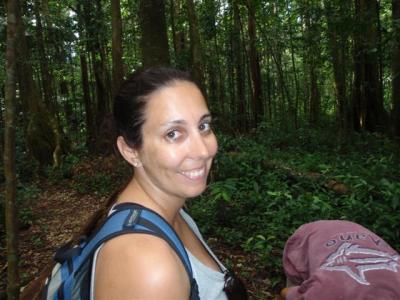
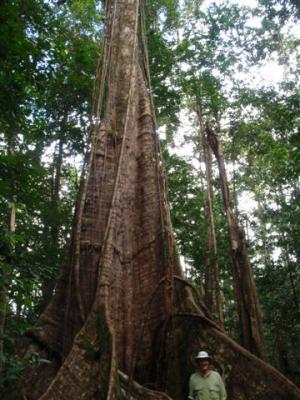
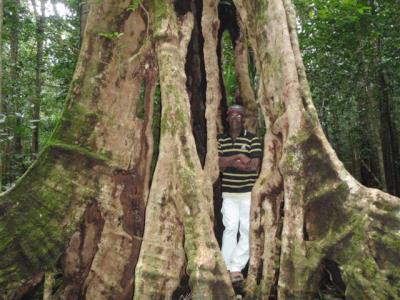
There are also quite a few parasitic species Winston pointed out, plants that live on a host tree. Most of the species of parasitic plants we have seen before, but one in particular was striking. It almost looks like a net, with thin, flimsy looking leaves making a weaved pattern up the tree.

The whole forest is full of moss, which is indicative of how moist it stays up here. It rained lightly on and off the whole time we were up there. There are lots of vines around, some of them the plant that Andrew had pointed out to us earlier. There were lots and lots of ferns in several species. Something that we thought was cool is there are quite a few trees that are intertwined. At first glance they look like one tree, but when you look more carefully, it is actually two trees wrapped around one another. We are not sure what this photo is of, but we found it interesting. Is the leaf of this plant supposed to be bumpy like this, or is it some kind of parasitic growth?
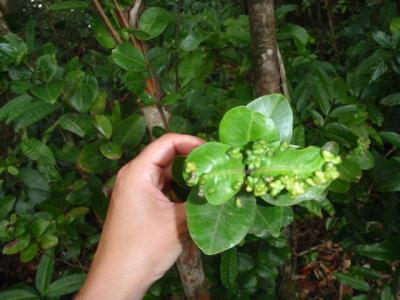
The draw to this park is that it is home to two species of parrots found only on Dominica, the Sisserou and Jaco Parrots. The Sisserou is an especially rare bird. They only lay one egg per “clutch” and thus don’t reproduce very quickly. The Jaco is more commonly seen. They lay three eggs per “clutch”. While in the park, Winston found three parrots. All three were high in the trees, and we didn’t get a good look at any of them. After the birds sat in their perch for a few minutes, unmoving and invisible to us, Eric and Christi went back to looking at the trees. The guys on Arielle are more patient with the bird watching than we are, and they sat thee watching until the birds finally moved again, so they got better views of the birds. We are not sure which breed we saw, but chances are thy were jacos. They are noisy little guys, squawking away loud enough for the whole forest to hear them.
From there, we went down the mountain quite a way, then turned off on a small road. Winston said it would take us to the Milton Waterfall hike. This road was unpaved and very rough. We didn’t follow the road very far before Winston stopped. He had taken us as far as he could without a 4 wheel drive vehicle. We all got out and continued on foot. The road turned into a muddy, uneven, rutted out track full of big rocks.
We were in the middle of farm land, and as we walked, Winston spent a lot of time telling us about the various foods they grow on Dominica. First, he picked some grapefruit and oranges for us, then cut them up for snacks. Both were sweet and delicious. He explained that using your nails on grapefruit pushes the bitterness out of the skin and into the meat, so the fruit tastes better when cut solely with a knife. He pointed out that there were a lot of grapefruit and oranges on the ground, and explained that the birds like to break into the fruit and eat the seeds out of it, ruining it for human consumption.
Winston pointed out nutmeg trees. When Christi mentioned that nutmeg is her favorite spice, he took her over to a tree. The fruit of the nutmeg tree looks like an especially large and not quite ripe apricot, yellow-orange in color. The fruit is inedible raw, but it is can be made into jams, jellies and syrups. The seed in the center has two coatings protecting it. The outer coating looks like red plastic and is dried out to make the spice mace. The inner coating is a hard black shell, which is grounded into nutmeg. So, when you open the fruit up, it looks like it has a red seed, but when you look closer you think it is a black seed under the red, but when you shake it you can hear the seed rattling within the black shell. Winston picked up a few seeds off the ground and gave them to Christi.
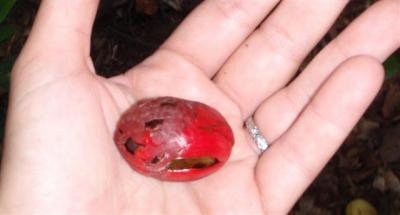
He pointed out a red plant with red flowers. They boil the flowers with some ginger to make a non-alcoholic beverage called sorrel, which is especially popular at Christmas time.
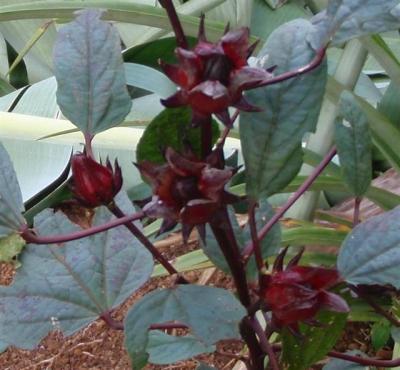
He showed us a plant called guinea grass. It is a funny name for the plant, because it is a fruit, not a grass. Apparently, if you shred a little bit of peel into a person or dog’s food, it makes them extra aggressive. Michael is holding the guinea grass and Jack is in the background.

He opened up a cocoa fruit for us to eat. The meat is soft and sweet, similar in appearance and texture to a soursop. And the fruit is yummy, but it doesn’t taste like chocolate. It is the seeds of the cocoa plant that are processed to make chocolate. The seeds certainly don’t look like anything special, and we don’t think they aren’t edible as is.
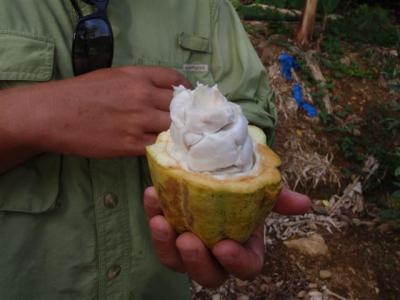
He showed us lots more, too, such as christophene vines, a grove of peppers, a cinnamon tree, and a pineapple plant. We could smell thyme in the air and knew there had to be a lot of it growing nearby. This is a photo of a pineapple just beginning to form into a fruit.
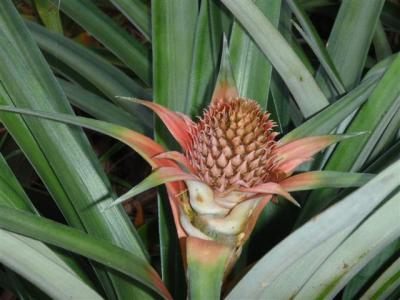
After we passed through the farms, we got to a barrier in the road that stopped car traffic. This was where the forest started. The road turned into a hiking trail and we followed it down a slope to a river. Down in this little river valley it was cool and moist, with lots of moss around. We crossed the river.
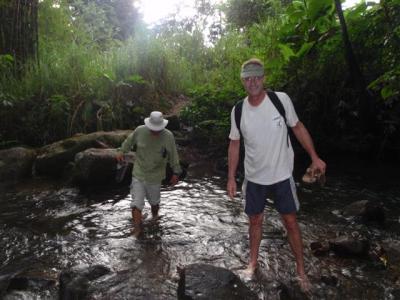
After only a few steps, we came to yet another river. The main river must have forked somewhere up stream. We crossed to the other side and walked up the river bank for a little way. The footing around the water was a little treacherous. It was muddy, so we were mostly stepping on smooth, algae covered stones to keep out of the muck, and we each slipped a couple times. Actually, even the footing on the road above wasn’t all that good, since it was also muddy, rocky, and hilly.
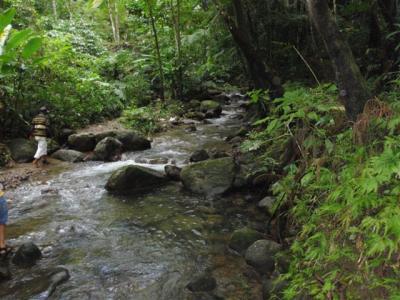
It wasn’t long before we came to the fall. It is 80 feet tall and brimming with water, sending a forceful torrent down into an inviting looking pool. Sadly, it is fenced off so you can’t go into the pool. But, since this a main water source for the area, there is good reason to not allow anyone in the water. Seeing the beautiful waterfall was a perfect end to a great day. Unfortunately, we couldn’t linger because it was getting dark. We hustled back up the hill to the van and headed back. Of course, once we were out from under the thick canopy of trees, it was lighter than down in the river.
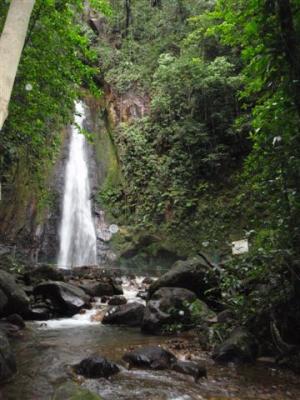
Winston dropped us back at the dinghy dock, where Andrew was waiting to collect for the day’s adventures. We had arranged both tours with Andrew, who had subcontracted Winston for the land tour. We had been told $20 USD for the boat tour and $30 USD for the land tour, for a total of $50 USD. It would up being $56 total, with the lion share going to Andrew and only a small portion going to Winston. We were a little upset at being charged more than what was originally quoted, but we were even more upset that Winston was getting screwed over. Andrew was a great guide, and yes, he had to do physical labor. But he didn’t spend very long with us. Winston spent hours and hours with us, used a lot of gasoline schlepping us around, also did physical labor in leading us on the two hikes, and is an amazing guide in terms of knowledge and personality. We wanted Winston to get more of the money than Andrew.
Since we had gotten so little sleep the night before, we were in bed early and slept like the dead.
